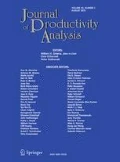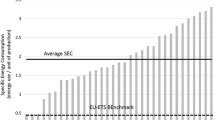Abstract
This study examines economic performance, environmental performance, and regulatory activity for plants in three industries: pulp and paper, oil, and steel. Stochastic frontier production function models show significant deviations from production efficiency. Older plants are less efficient in production, but perform no worse on emissions. Plants spending more on pollution abatement tend to do worse on both production efficiency and emissions. Stricter local regulatory pressure is associated with somewhat lower emissions, but has mixed effects on production efficiency. Positive correlations between SUR residuals for emissions and production efficiency suggest unmeasured plant-level characteristics that drive both economic and environmental performance.
Similar content being viewed by others
Notes
Regulatory pressures can be related to plant closings, as shown by Deily and Gray (1991) for the steel industry in the early1980s, but there were fewer closings in our industries during the current period.
Shadbegian and Gray (2005) used annual data on abatement costs for detailed inputs (not available for the 1990s) to make such adjustments to production function estimation.
It is also possible to decompose TE into two parts (1) pure technical inefficiency (i.e., not producing on the isoquant) and (2) deviations from constant returns to scale (i.e., producing under diminishing or increasing returns). By assuming constant returns, Farrell excluded the second part from his calculations.
In the two-stage estimation procedure, the first stage estimates the efficiency effects assuming they are independently distributed, while the second stage models them as a function of the plant’s characteristics (so the efficiencies for any two observations of the same plant would be correlated). Jointly estimating both stages is more efficient and removes this inconsistency in assumptions.
Note that FRONTIER estimates inefficiency measures (1/TE), not efficiency measures.
4-digit SIC deflators discussed in Bartelsman and Gray (1996) were used to put nominal values into real terms.
We categorize each plant’s technology based on information from their respective industry directories: Lockwood-Post Pulp and Paper Directory; Oil and Gas Journal; and Directory of Iron and Steel Plants.
DIRTY TECH for oil refineries is mostly connected to air pollution, but for consistency we include it in the water pollution models as well.
We would like to thank John Haltiwanger for providing the plant age information. In our analysis we used a single dummy to measure plant age (OLD = open before 1972) for two reasons: our sample includes some very old plants, likely to heavily influence any linear (or non-linear) age specification, and concern with environmental issues was not prominent before the 1970s.
All variables below that are measured relative to plant capacity are measured in this way.
For the TRI analysis we use total pollution abatement operating costs relative to plant size (PAOC).
Regressions include a dummy variable for missing Compustat data, MISSFIRM, which cannot be reported due to Census Bureau disclosure rules.
Particles of 2.5 μm or less in diameter.
Relatively few of our emissions reports are based on actual monitored emissions; the majority of emission reports are based on calculated emissions or engineering estimates, based on the capacity of the production process and the design efficiency of the installed pollution abatement equipment.
TRI chemicals are limited to those included in the ‘core chemical’ list for the 1988 TRI (found at http://www.epa.gov/triexplorer/list-chemical-core-88.htm).
Gray and Shadbegian (2005) found some evidence that compliance with air pollution regulations by plants which are owned by larger firms is less sensitive to inspections and more sensitive to enforcement actions than those owned by smaller firms.
We would like to thank Randy Becker, who created this dataset and graciously made it available to us for this project. The data is described in more detail in Becker (2005).
A revised version of the PACE survey was done in 1999, but it was not longitudinally consistent with the pre-1999 PACE data so it is not used here (see Becker and Shadbegian (2005) for more information).
Estimating small and insignificant contributions of capital to output is common in empirical results, as discussed in Griliches and Mairesse (1995).
See Kodde and Palm (1986) for a table of critical values for this test.
References
Aigner D, Lowell CAK, Schmidt P (1977) Formulation and estimation of stochastic frontier production function models. J Econom 6:21–37
Aiken DV, Pasurka CA (2003) Adjusting the measurement of US manufacturing productivity for air pollution emissions control. Resour Energy Econ 25:329–351
Bartelsman EJ, Gray WB (1996) The NBER manufacturing productivity database. NBER Technical Working Paper 205
Battese GE, Coelli TJ (1995) A model for technical inefficiency effects in a stochastic frontier production function model for panel data. Empir Econ 20:325–332
Becker RA (2005) Air pollution abatement costs under the clean air act: evidence from the PACE survey. J Environ Econ Manage 50:144–169
Becker RA, Shadbegian RJ (2005) A change of PACE: A comparison of the 1994 and 1999 pollution abatement costs and expenditures survey. J Econ Soc Meas 30:63–95
Berman E, Bui L (2001) Environmental regulation and productivity: evidence from oil refineries. Rev Econ Stat 83:498–510
Bernstein MA, Feldman SL, Schinnar AP (1990) Impact of pollution controls on the productivity of coal-fired power plants. Energy Econ 12:11–17
Boyd GA, McClelland JD (1999) the impact of environmental constraints on productivity improvement in integrated paper plants. J Environ Econ Manage 38:121–142
Coelli TJ, Prasada Rao DS, Battese GE (1998) An introduction to efficiency and productivity analysis. Kluwer Academic Publishers
Deily ME, Gray WB (1991) Enforcement of pollution regulations in a declining industry. J Environ Econ Manage 21:260–274
Denison EP (1979) Accounting for slower economic growth: the U.S. in the 1970s. The Brookings Institution, Washington
Directory of iron and steel plants, Association for Iron and Steel Technology (various issues)
Farrell MJ (1957) The measurement of productivity. J R Stat Soc 120:253–290
Gray WB (1987) The cost of regulation: OSHA, EPA and the productivity slowdown. Am Econ Rev 77:998–1006
Gray WB (1986) Productivity versus OSHA and EPA Regulations. UMI Research Press, Ann Arbor, MI
Gray WB, Deily ME (1996) Compliance and enforcement: air pollution regulation in the U.S. steel industry. J Environ Econ Manage 31:96–111
Gray WB, Shadbegian RJ (2005) When and why do plants comply? Paper mills in the 1980s. Law and Policy 27:238–261
Gray WB, Shadbegian RJ (2003) Plant vintage, technology, and environmental regulation. J Environ Econ Manage 46:384–402
Gray WB, Shadbegian RJ (2002) Pollution abatement costs, regulation, and plant-level productivity. In: Gray WB (ed) Economic costs and consequences of environmental regulation. Ashgate Publishing
Gollop FM, Roberts MJ (1983) Environmental regulations and productivity growth: the case of fossil-fueled electric power generation. J Polit Econ 91:654–674
Griliches Z, Mairesse J (1995) Production functions: the search for identification. NBER Working Paper 5067
Harrington W (1988) Enforcement leverage when penalties are restricted. J Public Econ 37:29–53
Kodde DA, Palm FC (1986) Wald criteria for jointly testing equality and inequality restrictions. Econometrica 54:1243–1248
Laplante B, Rilstone P (1996) Environmental inspections and emissions of the pulp and paper industry in Quebec. J Environ Econ Manage 31:19–36
Lockwood-post pulp and paper directory, Miller-Freeman Publishing Company, various issues
Magat WA, Viscusi WK (1990) Effectiveness of the EPA’s regulatory enforcement: the case of industrial effluent standards. J Law Econ 33:331–360
McGuckin RH, Pascoe GA (1988) The longitudinal research database: status and research possibilities. Surv Curr Bus 68:30–37
Meeusen W, van den Broeck J (1977) Efficiency estimation from Cobb–Douglas production functions with composed error. Int Econ Rev 18:435–444
Nadeau LW (1997) EPA Effectiveness at reducing the duration of plant-level noncompliance. J Environ Econ Manage 34:54–78
Oil and Gas Journal, PennWell Corporation (various issues)
Pitt MM, Lee LF (1981) The measurement and sources of technical inefficiency in the Indonesian weaving industry. J Devel Econ 9:43–64
Shadbegian RJ, Gray WB (2005) Pollution abatement expenditures and plant-level productivity: a production function approach. Ecol Econ 54:196–208
Shadbegian RJ, Gray WB (2003) What determines the environmental performance of paper mills? the roles of abatement spending, regulation, and efficiency. Topics Econ Anal Policy 3, http://www.bepress.com/bejeap/topics/vol3/iss1/art15
U.S. Bureau of the Census, pollution abatement costs and expenditures. U.S. Govt. Printing Office, Washington, DC, various issues
Acknowledgments
Financial support for the research from the National Science Foundation (Grant # SBR-9410059) and the Environmental Protection Agency (Grants # R-832155-01-0 and #R-826155-01-0) is gratefully acknowledged, as is access to Census data at the Boston Research Data Center, which is partially supported by the National Science Foundation (Grant #SES-0427889). Excellent research assistance was provided by Anna Belova and Bhramar Dey. The opinions and conclusions expressed are those of the author and not the Census Bureau, EPA, or NSF. All papers are screened to ensure that they do not disclose confidential information. Any remaining errors or omissions are the authors’.
Author information
Authors and Affiliations
Corresponding author
Rights and permissions
About this article
Cite this article
Shadbegian, R.J., Gray, W.B. Assessing multi-dimensional performance: environmental and economic outcomes. J Prod Anal 26, 213–234 (2006). https://doi.org/10.1007/s11123-006-0017-3
Published:
Issue Date:
DOI: https://doi.org/10.1007/s11123-006-0017-3




